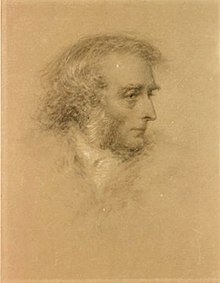John Martin (painter)
He was celebrated for his typically vast and dramatic paintings of religious subjects and fantastic compositions, populated with minute figures placed in imposing landscapes.
Martin's paintings, and the prints made from them, enjoyed great success with the general public, with Thomas Lawrence referring to him as "the most popular painter of his day".
[3] His brothers were William, the eldest, an inventor; Richard, a tanner who became a soldier in the Northumberland Fencibles in 1798, rising to the rank of Quartermaster Sergeant in the Grenadier Guards and fought in the Peninsular War and at Waterloo; and Jonathan, a preacher tormented by madness who set fire to York Minster in 1829, for which he stood trial.
His landscapes have the ruggedness of the Northumberland crags, while some authors claim that his apocalyptic canvasses, such as The Destruction of Sodom and Gomorrah, show his familiarity with the forges and ironworks of the Tyne Valley and display his intimate knowledge of the Old Testament.
Martin's first break came at the end of a season at the Royal Academy, where his first major sublime canvas Sadak in Search of the Waters of Oblivion had been hung—and ignored.
In 1816 Martin finally achieved public acclaim with Joshua Commanding the Sun to Stand Still upon Gibeon, even though it broke many of the conventional rules of composition.
In 1818, on the back of the sale of the Fall of Babylon for £420 (equivalent to £30,000 in 2015),[5] he finally rid himself of debt and bought a house in Marylebone, where he came into contact with artists, writers, scientists and Whig nobility.
Despite an often cited singular instance of his hissing at the national anthem, he was courted by royalty and presented with several gold medals, one of them from the future Russian Tsar Nicholas I, on whom a visit to Wallsend colliery on Tyneside had made an unforgettable impression: "My God," he had cried, "it is like the mouth of Hell."
Georges Cuvier became an admirer of Martin's, and he increasingly enjoyed the company of scientists, artists and writers—Charles Dickens, Michael Faraday and J. M. W. Turner among them.
[6] Martin began to experiment with mezzotint technology, and as a result was commissioned to produce 24 engravings for a new edition of Paradise Lost—perhaps the definitive illustrations of Milton's masterpiece, of which copies now fetch many hundreds of pounds.
His first exhibited subject picture, Sadak in Search of the Waters of Oblivion (now in the St. Louis Art Museum), was hung in the Ante-room of the Royal Academy in 1812, and sold for fifty guineas.
It was followed by the Expulsion (1813), Adam's First Sight of Eve (1813), Clytie (1814), Joshua Commanding the Sun to Stand Still upon Gibeon (1816) and The Fall of Babylon (1819).
In 1820 appeared his Belshazzar's Feast, which excited much favourable and hostile comment, and was awarded a prize of £200 at the British Institution, where the Joshua had previously carried off a premium of £100.
A 2,000-square-foot (190 m2) version of Belshazzar's Feast was mounted at a facility called the British Diorama in 1833; Martin tried, but failed, to shut down the display with a court order.
Some of the more notable prints include Pandæmonium and Satan Presiding at the Infernal Council, remarkable for the science fiction element visible in the depicted architecture, and arguably his most dramatic composition Bridge over Chaos.
His profile was raised further in February 1829 when his elder brother, non-conformist Jonathan Martin, deliberately set fire to York Minster.
His 1834 plans for London's sewerage system anticipated by some 25 years the 1859 proposals of Joseph Bazalgette to create intercepting sewers complete with walkways along both banks of the River Thames.
[9] Debt and family pressures, including the suicide of his nephew (Jonathan's son Richard), brought on depression, which reached its worst in 1838.
Martin's fantasy architecture influenced the Glasstown and Angria of the Brontë juvenilia, where he himself appears as Edward de Lisle of Verdopolis.
Its magical strains conjure up Babylon, the hanging gardens of Semiramis, the marvels of Nineveh, the mighty constructions of Mizraim, as we see them in the pictures of the English painter Martin.
A number of Martin's engineering plans for London which included a circular connecting railway, though they failed to be built in his lifetime, came to fruition many years later.
Connections between his dramatic style and the arts and culture of the historically charged post-war period in Britain has been assessed by Anguix-Vilches who sees post-World War II enthusiasm for depictions of the Apocalypse as allowing Martin’s work to survive.
John Martin wrote two autobiographies, the first an article in The Athenaeum of 14 June 1834, page 459 and the most extensive in The Illustrated London News, 17 March 1849, pp. 176–177.
The first full biography was that by Mary L. Pendered whose chief source, Martin's friend Sergeant Ralph Thomas, wrote a diary – now lost – of their friendship.
Leopold accompanied his father on many walks and visits, and his anecdotes include encounters with J. M. W. Turner, Isambard Kingdom Brunel, William Godwin and Charles Wheatstone.
Martin's eldest brother, William (1772–1851) was by turn a rope-maker, soldier, inventor, scientist, writer and lecturer, who attempted to develop a rival philosophy to "Newtonian" science, allowing for perpetual motion, and denying the law of gravity.



